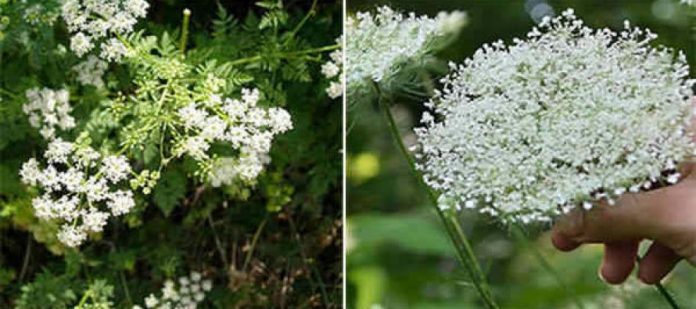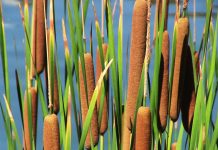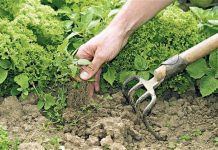The edible and healing Queen Anne’s Lace is a member of the same family as the poisonous Hemlock and the plants and are similar in appearance. When using a plant, you should always be confident of your identification, but the stakes are very high in this case. Here, we will go over the differences to help you distinguish the two species.
Use Caution When Identifying Plants
Since all parts of the water hemlock are poisonous, please use caution when handling the plant for identification and do not harvest any plant until it is clearly known. I wear gloves when handling plants such as hemlock for identification or other purposes.
Contrary to some beliefs, hemlock does not cause contact rash or irritation. Once ingested, the poison is active, but it can also be transmitted to your mouth or eyes, and can be absorbed through cuts or wounds. Even the minimal levels can be dangerous.
Look at the Flowers
All plants have white flowers which blossom like clusters called an umbrella. The flower clusters of the Queen Anne lace’s are arranged uniformly over the top while the Hemlock flowers are more spread out with more space between the smaller flower clusters.
One way to completely recognise Queen Anne’s lace is to find the single purple or red flower in the center of the umbrel. If the flower is present, it is certainly Queen Anne’s lace. However, the floral absence does not indicate the plant is hemlock. Some Queen Anne’s lace varieties also lack the center purple flower.
Related: 28 Garden Remedies for Inflammation
Compare All Differences
The two plants look very similar, and may be confused. I’m giving you a chart below with plant comparisons, but I suggest that you don’t rely on any one characteristic and don’t rely on memory unless you’re able to tell the plants apart. A error can be fatal.
The healing Queen Anne’s lace plant is hairy. It has hair on the leaves’ undersides and on the floral base. The flowers are arranged in a tight, flat topped umbrel, that grows at the end of a solid green stem.
Hemlock grows almost twice as tall as the Queen Anne’s lace, but this alone is not sufficient to differentiate between the plants. Hemlock flowers emerge with dark red or purple spots at the end of a hollow stem that is often splotched or dotted. The umbrel is made more rounded and more open.
Comparison Points for Hemlock to Queen Anne’s Lace
1. Compare plant height. Hemlock grows to be 6 to 10 feet tall, while Queen Anne’s lace is only 3 to 6 feet in height.
2. Compare the flower stem. Hemlock has a smooth, thick stem with red or purple splotches of varying sizes. Hemlock stems can be completely purple or have purple stripes. Queen Anne’s flower stems are thinner and green or green with long red stripes.
3. Hemlock flower stems are smooth on the outside and hollow on the inside. Queen Anne’s lace flower stems are more solid and have short hairs that should be visible in a close look and feel fuzzy to the touch.
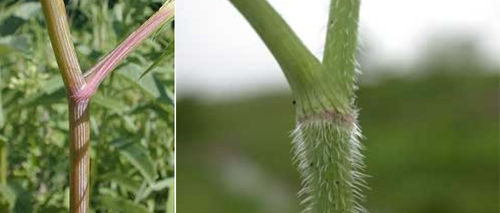

5. Hemlock flowers are more spread out with more space between the smaller flower clusters while Queen Anne’s lace flowers form a tighter pattern with less space between the flowers.
Hemlock umbrels are rounded while Queen Anne’s lace umbrels are flat across the top.
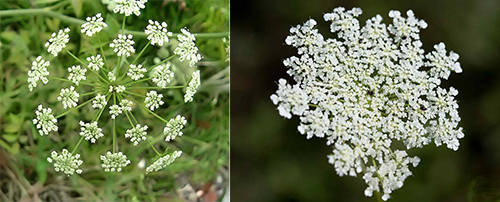

7. Queen Anne’s lace sometimes has a single reddish or purple flower in the center of each umbrel. Locating this single red or purple flower is definitive for Queen Anne’s Lace, but not all varieties have this sign. Hemlock never has this blood colored flower.
8. Dried hemlock umbrels retain their original shape while Queen Anne’s lace umbrels curl into a bird’s nest shape when dry.
9. Hemlock leaves are finely divided and lacy. They are tripinnate and alternate in a pinate pattern. Serrations are sharply pointed. Queen Anne’s Lace leaflets are lanceolate and serrated. Each is 2 to 4 inches in length with serrations that are more rounded at the tips. The lower side of the leaves is slightly hairy.
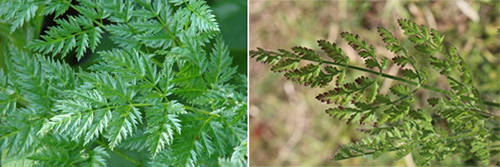

11. Compare the roots. Hemlock roots are thickened tubers that grow deeper and spread more than the Queen Anne’s lace tap root. Hemlock roots produce an oily juice that turns reddish brown on exposure to air. Queen Anne’s Lace root is also known as wild carrot and is shaped like a thin carrot. It is usually a single tap root.
Related: This Common Driveway Weed is One of Nature’s Most Powerful Survival Plants
Helpful Ways to Remember the Plants
Over the years, stories have been created by foragers and herbalists to help them remember which plant is healing and which is lethal. Here are two such devices:
Legend has it that when Queen Anne was sewing a piece of lace, she pricked her finger and dropped into the middle of the flowers with a single drop of blood, giving them the single red or purple flower in the middle of each umbrel. The appearance of this blood colored flower for Queen Anne’s Lace is a good sign, and it’s healing properties.
Another way of recognizing the plant is to think of lifting Queen Anne’s skirt and showing off her hairy legs. She would definitely never have done such a thing, but Queen Anne’s lace has hairy stems and the image will help you remember the truth.
When harvesting any plant, positive identification is mandatory, but particularly when dealing with a plant like the hemlock. Even a little taste is enough to kill you, therefore, no mistakes are permitted. You will have no trouble finding them once you know the plant well. In the meantime, please take the time to compare all the identifying features. I hope this article will help.



